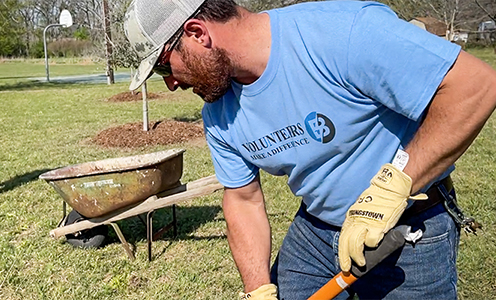Whisper Valley, a master-planned community in the Manor area, offers a unique package of green features, including solar panels, a geothermal heating and cooling system, and community gardens.
BY WILL HOLFORD
Unfolding in the rolling hills south of Manor in Travis County is a community offering a unique combination of renewable energy generation, energy-efficient homes and sustainable living.
Whisper Valley, a 2,060-acre, master-planned development on FM 973 just east of the Texas 130 toll road, began constructing homes in July 2017. The developers’ goal is that every home will be capable of producing as much energy as the home uses.
Each house has rooftop solar panels. An elaborate system of deep pipes use the Earth’s temperature to control the climate in each home. Plots of land are reserved for community gardens to grow produce and pastures to raise cattle, all for residents to consume.
Whisper Valley plans to have 7,500 homes when the community is built out in as early as 10 years. The vision is a development of seven “villages,” which would include 2 million square feet of retail and commercial space, as well as a public elementary school and middle school in the Del Valle school district.
The development’s first phase will include 237 homes ranging from about 1,100 square feet to 2,700 square feet, priced from about $200,000 to around $400,000. As of early July, 66 homes had been sold and another 43 were under construction. The development will include 700 acres of green space, anchored by a 600-acre park with hike-and-bike trails, greenbelts, an orchard and organic gardens. Residents in the first phase have access to an amenity center with a gym and resort-style pool heated by a geothermal system.
Boston-based Taurus Investment Holdings is developing Whisper Valley with EcoSmart Solution, an Austin subsidiary of Taurus, and working with homebuilders Avi Homes and Pacesetter Homes.
“Every home in Whisper Valley is designed and built to allow homeowners to control their energy destiny to achieve net zero consumption, or to even generate enough power to put it onto the electric grid,” said Axel Lerche, CEO of EcoSmart Solution. Lerche, a tall, lively native of Germany, started the company in order to provide Whisper Valley’s smart-home technology, geothermal systems, solar arrays and energy-efficient appliances.
Net zero consumption means a home’s renewable energy system generates roughly the same amount of power that the home consumes on an annual basis. That’s not always feasible, so the homes are connected to a utility’s electric system to ensure a continuous power supply. When a home generates more power than it can use at any given time, that power can go to a utility’s electric grid and the homeowner is paid for that excess power.
Bluebonnet Electric Cooperative is providing underground electric lines that will serve about 70 percent of the development, with Austin Energy providing power to the remaining 30 percent.
“Whisper Valley was an amazing opportunity to start from scratch,” Lerche said. “We were committed to smart land planning. One of the keys was working with Bluebonnet to understand the utility’s policies and business to create a better infrastructure. But all that has to be done from the beginning; otherwise, it’s not feasible.”
One of the unique features of Whisper Valley is a community-wide, interconnected system of pipes that provide geothermal heating and cooling for residents. The “geogrid” consists of vertical pipes in boreholes 300 to 360 feet deep at each home. These long pipes are connected by horizontal pipes buried 6 feet below ground. Each home has a 2- or 3-ton Bosch geothermal heat pump in the attic. The pump transfers the warmth or coolness of the water into air that is further warmed or cooled to the desired temperature and circulated through ductwork into the home.
The geogrid was installed at the same time as the development’s other infrastructure, long before any homes were built. The cost of the geogrid is part of a home’s purchase price. Each resident pays $60 per month to EcoSmart, which covers the geogrid’s operation, maintenance, repair and warranty costs.
“The geogrid and geothermal heat pumps in the homes result in a 60 to 70 percent reduction in energy demand,” Lerche said. That equates to significantly lower electric bills for Whisper Valley residents compared to homes with traditional heating and cooling systems.
Each home’s roof-mounted solar array is capable of generating 4 to 6 kilowatts of power. The homes are insulated with high-density spray foam in the walls and enclosed attic spaces. They include a technology package that has Google Fiber high-speed internet service, Nest smart home thermostats and alarm systems, energy-efficient appliances and wiring for electric vehicle chargers.
Jayme Howard and her two dogs, Cato and Zoe, moved to Whisper Valley from San Marcos in April. She loves the community’s “vibe” and its sustainable living features, especially the solar arrays, energy-efficient homes and community gardens.
“I’m originally from Las Vegas,” Howard said, “so I can’t grow anything. But I buy the produce grown at the community gardens during the farmer’s markets we have.”
Howard works from home, so she really appreciates the geothermal air conditioning. “I’ve got an 1,100-square-foot home with a dog door, and I keep the thermostat at 75 degrees,” she said. “I haven’t had an electric bill above $60.”
Howard knew she was in the right place the first time she saw her home.
“I didn’t want a big house,” she said. “I looked at townhomes, but I have a 12-year-old lab who doesn’t do stairs. I just fell in love with this house.”
Lerche said the key to Whisper Valley’s success is the willingness of everyone involved to take a step in an energy-efficient and sustainable direction.
“We all knew there was a better way to develop land and design and build homes,” he said. “We just had to find the right time and the right place.”
For more information on Whisper Valley, go to whispervalleyaustin.com.





